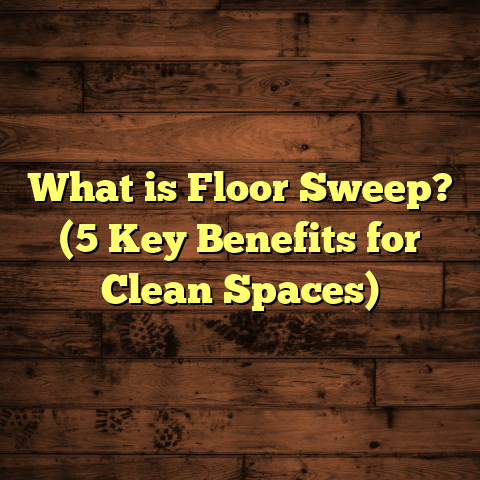What is a Timber Floor? (5 Key Benefits You Didn’t Know)
Trends in home design keep evolving, and lately, I’ve noticed timber floors making a strong comeback. It’s not just about nostalgia anymore—timber flooring now blends classic appeal with modern technology and sustainability. More homeowners and designers are choosing timber because it brings a warmth and authenticity to spaces that other materials struggle to match.
Having been in the flooring business for years, I’ve installed everything from vinyl and laminate to tile and carpet. But timber remains my favorite. There’s something about the look and feel of real wood that never grows old or goes out of style.
In this article, I want to share what I’ve learned about timber floors: what they are, why they’re worth considering, how they compare to other options, and some lesser-known benefits that might surprise you. I’ll also share stories from my own projects and explain how tools like FloorTally have helped me deliver better results for clients.
What Is a Timber Floor?
Let’s start with the basics: what exactly is a timber floor? The term “timber floor” generally refers to flooring made from real wood planks. Unlike laminate or vinyl flooring—which have synthetic layers designed to mimic wood—timber floors are crafted from natural wood harvested from trees.
There are two main types:
- Solid Timber Flooring: This consists of planks cut from a single piece of wood, typically around 18-20mm thick. Because it’s solid wood throughout, it can be sanded and refinished multiple times over its lifetime.
- Engineered Timber Flooring: Made with a veneer of real wood on top of several layers of plywood or high-density fiberboard arranged in a cross-grain pattern. Engineered floors are more stable in humid or fluctuating climates and can be installed in places where solid wood might warp.
The species of wood used varies widely—common choices include oak, maple, walnut, cherry, and more exotic options like teak or Brazilian cherry. Each species has unique grain patterns, colors, hardness levels, and durability.
I remember a project where we used reclaimed American walnut. The character and imperfections in the wood added a rich story to the floor that perfectly matched the client’s vintage-style home.
How Timber Floors Are Made
The process usually starts with selecting logs from sustainably managed forests. These logs are then dried carefully to reduce moisture content to about 6-8%, which helps prevent warping later on.
Next comes milling—cutting the logs into planks of various widths and lengths. These planks are then planed smooth and sometimes brushed or wire-brushed to add texture before finishing with stains or protective coatings.
Finishes range from traditional oil-based varnishes to modern water-based polyurethanes that offer clear protection without yellowing over time.
Comparing Timber Floors to Other Flooring Options
Over the years, I’ve worked with many different flooring materials. Each has its pros and cons depending on budget, location, use case, and style preferences. Here’s a detailed comparison based on my hands-on experience:
Laminate Flooring
Laminate is often chosen as a cheaper alternative to timber because it looks similar at first glance. However, laminate is basically layers of fiberboard topped with a photographic image of wood grain covered by a protective clear layer.
- Pros: Affordable, easy to install (sometimes as a floating floor), resistant to scratches and stains.
- Cons: Feels less natural underfoot; no way to refinish once worn; tends to sound hollow; can be damaged by moisture.
I once installed laminate in a rental property where budget was tight. While it held up reasonably well for a couple of years, tenants complained it felt cold and synthetic compared to their previous timber floor. The owner ended up replacing it with engineered timber after one lease cycle.
Vinyl Flooring
Vinyl has become very popular due to its water resistance and versatility. Luxury vinyl planks (LVP) can mimic timber quite convincingly nowadays.
- Pros: Waterproof, easy maintenance, soft underfoot.
- Cons: Synthetic feel; often cheaper looking up close; environmental concerns regarding PVC content.
Clients love vinyl in bathrooms or kitchens but often choose timber for living areas for that natural warmth and authenticity.
Tile Flooring
Tiles—ceramic or porcelain—are great for wet areas and heavy traffic zones.
- Pros: Durable, water-resistant, wide variety of styles.
- Cons: Cold and hard underfoot; grout lines require maintenance; installation is labor-intensive.
I’ve installed tile in some kitchens but always recommend timber or engineered wood for adjacent living spaces to maintain warmth and comfort.
Carpet Flooring
Carpet offers softness and sound absorption but tends to trap allergens and requires regular cleaning.
- Pros: Comfortable; good insulation; variety of colors.
- Cons: Stains easily; harbor dust mites and allergens; wears quickly in high traffic.
While carpet can be cozy in bedrooms, many homeowners I’ve worked with prefer timber for living rooms or hallways because it’s easier to clean and lasts longer.
Why Timber Stands Out
What makes timber floors special is their ability to evolve with your home. Unlike laminate or vinyl that show wear over time without options for repair, timber floors can be sanded down and refinished multiple times—sometimes lasting over a century if maintained properly.
Also, no two timber planks are alike. Their natural grain patterns create an organic depth that synthetic options can’t replicate.
5 Key Benefits of Timber Flooring You Didn’t Know
Now let me share some benefits I’ve discovered that many people don’t realize when thinking about timber floors.
1. Timber Floors Improve Indoor Air Quality
Carpets trap dust mites, pet dander, pollen, and other allergens that can worsen respiratory issues like asthma or allergies. Timber floors don’t harbor these particles—instead, they allow for easier cleaning through sweeping or vacuuming.
In fact, research published in the Journal of Allergy and Clinical Immunology found homes with hardwood floors had 25% fewer airborne allergens than carpeted homes. This was confirmed by clients who reported noticeably better air quality after switching their carpets for timber floors.
One family I worked with had two young kids prone to allergies. After installing timber floors throughout their living areas, they told me how much calmer their kids’ breathing became during allergy season. That was powerful proof of timber’s health benefits beyond aesthetics.
2. Timber Floors Are Surprisingly Durable
Wood species vary greatly in hardness—a characteristic measured by the Janka hardness scale which rates how much force is needed to embed a steel ball into the wood surface.
For example:
| Wood Species | Janka Hardness (lbf) |
|---|---|
| Oak | 1,200 |
| Maple | 1,450 |
| Hickory | 1,820 |
| Jarrah | 1,560 |
I once installed jarrah timber flooring in a busy café kitchen area known for heavy foot traffic and dropped utensils. After three years, the floor still looked amazing with only minor scratches that were easily refinished during annual maintenance.
This durability makes timber floors suitable not just for homes but also commercial spaces where longevity matters.
3. Timber Flooring Adds Real Value to Your Home
Real estate experts consistently report that homes with hardwood floors sell faster and at higher prices than those without. According to data from the National Wood Flooring Association (NWFA):
- Homes with hardwood floors can increase resale value by up to 5%.
- Hardwood floors appeal strongly to buyers who prioritize quality finishes.
When I work with clients preparing their homes for sale, upgrading old carpet or laminate to timber often yields significant returns on investment. One client saw their property sell within two weeks after installing solid oak floors throughout the main living spaces—something they credited heavily in feedback from buyers.
4. Timber Flooring Offers Great Thermal Performance
Unlike tile or stone which can feel cold underfoot in winter, timber naturally insulates heat. The cellular structure of wood traps air pockets which provide insulation against temperature swings.
This means:
- Timber floors stay warmer during colder months.
- They help reduce heating bills by retaining warmth longer.
- In summer months, timber feels cooler than carpet but warmer than tile.
Energy.gov notes that wood flooring offers up to 20% better thermal insulation compared to stone or ceramic tiles under similar conditions.
I often recommend timber flooring for clients who want comfortable year-round living without relying heavily on underfloor heating systems—which can be expensive to install and run.
5. Unique Aesthetic and Design Versatility
Every plank of timber has its own story told through grain patterns, knots, and color variations. This natural variation creates depth and richness unmatched by synthetic flooring options.
Beyond just color choices, you can customize timber floors through:
- Different plank widths (narrow vs wide).
- Finishes ranging from matte oil-based oils to glossy polyurethanes.
- Installation patterns like herringbone or chevron for visual interest.
- Mixing species for contrast (e.g., dark walnut alongside lighter oak).
One client wanted an industrial loft vibe mixed with rustic charm. We combined reclaimed pine floors with exposed brick walls—a combination they loved because it felt authentically worn yet stylishly modern.
My Personal Experience With Timber Floor Installation
Throughout my career as a flooring contractor, I’ve handled countless timber floor installations—each one teaching me something new about the material’s versatility and challenges.
One common issue is accurate cost estimation. Timber flooring prices vary widely depending on species chosen, plank size, finish type, room complexity (stairs? angled walls?), and labor rates in your area.
I used to spend hours collecting quotes from suppliers, calculating waste percentages (usually around 5-10%), then estimating labor based on room size and prep work needed.
Then I discovered an online tool called FloorTally that changed everything for me.
How FloorTally Helps Me Manage Flooring Projects
FloorTally lets me input exact room dimensions along with material choices like species type, plank size, finish options—and it automatically calculates:
- Material costs
- Labor estimates based on local rates
- Waste factors so I don’t underestimate how much wood I need
- Total project costs clearly broken down
Using FloorTally has saved me hours per estimate and improved transparency with clients who appreciate seeing exactly where their budget goes.
One recent project involved renovating a 150-square-meter family home with engineered oak flooring throughout multiple rooms including kitchen and hallway (which required moisture-resistant flooring). By inputting all these details into FloorTally upfront, we avoided costly overruns because the tool accounted for tricky cuts around doorways and staircases—something I might have missed in manual calculations.
More Detailed Insights Into Timber Floor Maintenance
A question I get asked frequently: “How much upkeep do timber floors need?” People worry about scratches, water damage, or dull finishes.
Here’s what I tell them based on my experience:
- Routine Cleaning: Sweep or vacuum regularly to remove dirt which could scratch the surface.
- Avoid Excess Water: Use damp mops—not soaking wet—to clean spills quickly.
- Protective Measures: Felt pads under furniture legs prevent dents.
- Refinishing: Every 7-10 years (depending on wear), sanding down the surface restores original beauty.
- Humidity Control: Maintaining home humidity between 40%–60% avoids expansion or contraction issues.
I recently helped a client who had neglected their oak floor for years. After professional sanding and resealing treatment, the floor looked almost brand new again—a reminder that proper maintenance preserves the investment long term.
Sustainability of Timber Flooring
More homeowners ask me about environmental impact nowadays. Is real wood flooring eco-friendly?
The answer depends:
- Sustainably Sourced Timber: When sourced from responsibly managed forests certified by organizations like FSC (Forest Stewardship Council), timber flooring offers a renewable resource option.
- Longevity: Because timber floors last decades—even centuries—they don’t need replacing as often as synthetic alternatives.
- Carbon Storage: Wood stores carbon dioxide absorbed during tree growth—a natural carbon sink.
I always encourage clients interested in green building practices to choose FSC-certified wood species or reclaimed timber wherever possible.
Extended Case Study: Large Renovation Project With Timber Floors
Last year I worked on a major renovation of a heritage-listed Victorian home spanning over 250 square meters. The owners wanted authentic period features combined with modern durability.
We selected solid oak boards cut in traditional tongue-and-groove style with hand-scraped texture for character. The installation included multiple rooms plus stairs which required precise cutting around balusters.
Using FloorTally helped manage budgeting across this complex project including:
- Estimating higher labor rates typical of heritage restoration.
- Accounting for waste due to irregular wall angles.
- Including extra materials for stair treads matching main floorboards.
The project took four weeks but the result was stunning—the warm oak floor perfectly complemented original moldings while providing hard-wearing surfaces for family life.
The owners reported increased satisfaction with their investment compared to previous homes where they’d used laminate or vinyl in similar spaces that wore out quickly within five years.
FAQs About Timber Flooring Based on My Experience
Q: Can timber floors be installed over concrete?
A: Yes! Engineered timber is ideal over concrete slabs because it handles moisture better than solid wood. A moisture barrier is essential regardless of type.
Q: How long does installation take?
A: Depends on room size and complexity but typically 3–7 days for average rooms under 100 square meters.
Q: Are timber floors noisy?
A: They can creak if not installed properly over well-prepared subfloors. Using underlayments helps reduce noise transmission too.
Q: What’s better—solid or engineered?
A: Solid timber offers more refinish options but engineered is more dimensionally stable in humid areas like kitchens or basements.
To wrap this up (without saying “in conclusion”), timber flooring is much more than just a pretty surface beneath your feet. It’s durable,
healthy,
energy-friendly,
and uniquely beautiful.
If you’re thinking about upgrading your floors,
why not explore the options?
I’m happy to share more advice tailored specifically to your space if you want—just ask!
Have you ever lived on a timber floor? I’d love to hear your stories too—what stood out most?





